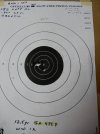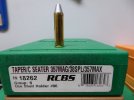to get twice as haarder you'd have to go to lino-type.
increasing antimony from 3 to 6 gets you a whopping [drum roll here] 3~BHN points.
go to 9 and you get more,,, 3 more, go all the way to 12 percent antimony [4 times as much as the original 3%] and you go from 11-12B all the way to 20-21 or so.
what i think your thinking about is a tougher alloy.
even there you have a point where you get no return, you lose the malleability, reflexivness [yeah i made that one up] of the alloy, and the ability to retain gas behind the bullet throughout the barrels slight dimension variances.
where the sweet spot happens to be with a lead alloy as far as being able to do all that and resist shear forces,,, is just right about where wheel weight alloy happens to be.
2.5 to 4% antimony and somewhere close to 2% tin gives you all the tear resistance and hardness you need.
so picking an easy for you to make alloy, that falls within that range and working with it is actually your best bet.
2.5% tin and 2.5% antimony is a very good choice, 2% tin instead or even 1.5% is enough to do all the work that needs to be done by it within the alloy itself.
going to something like 2% tin and 4% antimony is 'probably' at the highest end of the toughness spectrum where the alloy still retains enough shear strength and flexibility to do all that work while still maintaining enough structural integrity to resist higher acceleration forces.
your already running a gas check, so you get to skip all the problems and can simply let the copper chunk on the base do a ton of that work for you.
it's already got a BHN of like 35 [unless your using brass gas checks then it's like 80] not as hard as glass mind you but nowhere near as brittle either.
here's the other thing to keep in mind.
if you want to use your bullets for hunting your swinging the pendulum in another direction altogether.
you ever seen a bullet manufacturer show a bunch of pictures of their 30 cal. hunting bullets that looked like they just fell out of the box, only with rifling marks in them?
maybe with some 4-500gr. African solids,, that was necessary to drive through 6 foot of elephant or buffalo or the like.
i doubt your gonna try that with your 357, so your looking for some expansion along with the accuracy and the penetration your already gonna get.
for that you need malleability/ toughness built into your alloy, and you need it at various velocities... say,, you know a 20yd versus a 120 yd distance where you've lost a couple hundred feet per second.
close up,, full speed you get 50yd 7mm mag on the shoulder performance with a brittle bullet.[only it doesn't have to be on the shoulder]
further out? well you need some smack when the bullet gets there since you can't rely on speed to make the bullet bigger.
part of that equation [actually all of it] is nose shape and diameter of the meplat and the other two parts are speed [higher isn't always better] and alloy.
if you were using a 30 cal rifle to hunt with i could simply write a prescription for success.
if you were defending your home with a snub nose 38 special i could also give you the recipe for success.
and since i've shot a few deer with a lever rifle i can go ahead and say with confidence use something softish at a moderate velocity [14-1500 fps] and a design that has a flat nose.
that's enough for now i guess.


